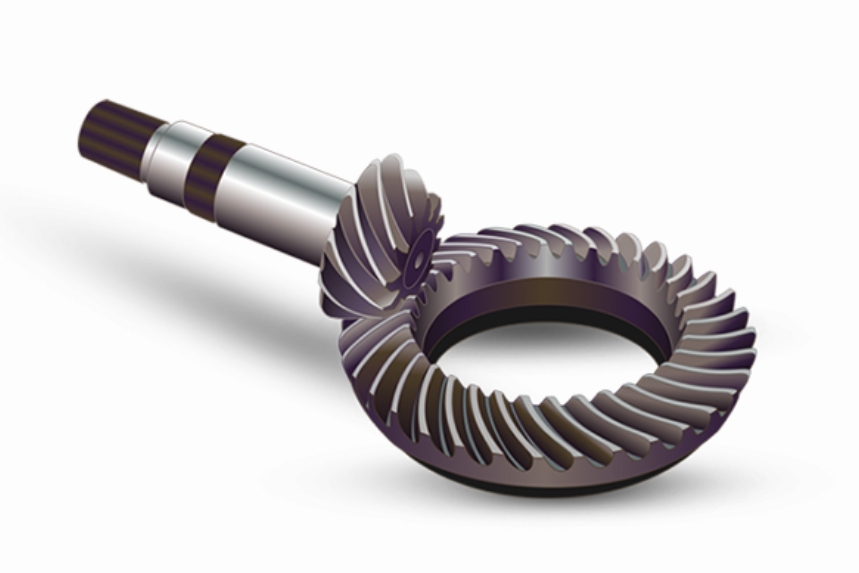This paper presents a systematic methodology for detecting transmission errors in double circular arc spiral bevel gears, combining theoretical modeling with advanced coordinate transformation techniques. The study focuses on solving the complex nonlinear interactions between tooth profile deviations and elastic deformations that cause edge contact phenomena and coordinate system distortion.

1. Mathematical Modeling of Spiral Bevel Gear Transmission
The coordinate system for spiral bevel gears incorporates both geometric parameters and elastic deformation factors:
$$
\begin{cases}
e_x = \frac{g}{Z} \exp\left(-\frac{k_x}{2}\right) + \sin\left(\beta + \delta_x\right) \\
e_y = \frac{g}{Z} \exp\left(-\frac{k_y}{2}\right) + \sin\left(\beta + \delta_y\right)
\end{cases}
$$
Where:
$g$ = Tooth alignment error
$Z$ = Number of teeth
$\beta$ = Spiral angle
$\delta$ = Elastic deformation function
2. Error Propagation Mechanism
The transmission error function considers multiple operational parameters:
$$
\Delta f = \left|\vec{v}_0 \cdot \left(f_{\text{actual}} – f_{\text{ideal}}\right)\right|
$$
Key factors influencing transmission accuracy:
| Factor | Impact Level | Compensation Method |
|---|---|---|
| Tooth Profile Deviation | High (0.8-1.2μm) | Normal Offset Correction |
| Elastic Deformation | Medium (0.3-0.6μm) | Load Distribution Optimization |
| Assembly Misalignment | Critical (1.5-2.0μm) | Coordinate Transformation |
3. Coordinate Transformation Framework
The detection algorithm employs a multi-stage coordinate transformation process:
$$
\begin{bmatrix}
x’ \\
y’ \\
1
\end{bmatrix}
=
\begin{bmatrix}
\cos\theta & -\sin\theta & t_x \\
\sin\theta & \cos\theta & t_y \\
0 & 0 & 1
\end{bmatrix}
\begin{bmatrix}
x \\
y \\
1
\end{bmatrix}
$$
Where $\theta$ represents the rotational compensation angle and $t$ denotes translational offsets.
4. Error Detection Methodology
The normal offset algorithm calculates the minimum distance between actual and ideal profiles:
$$
\Delta G = \min\left[\sum_{i=1}^n \left(\frac{\|p_i – q_i\|}{\sqrt{1 + \left(\frac{dy}{dx}\right)^2}}\right)\right]
$$
Key detection parameters for spiral bevel gears:
| Parameter | Measurement Accuracy | Sampling Density |
|---|---|---|
| Tooth Profile | ±0.8μm | 200 points/tooth |
| Lead Angle | ±15 arcsec | 50 points/mm |
| Pitch Deviation | ±1.2μm | Full Tooth Scan |
5. Experimental Validation
Testing results under varying load conditions:
$$
\text{TE} = \frac{1}{N}\sum_{i=1}^N \left|\theta_{\text{input}} – \frac{Z_2}{Z_1}\theta_{\text{output}}\right|
$$
Performance comparison of detection methods:
| Method | Detection Error (μm) | Computation Time (ms) |
|---|---|---|
| Proposed Method | 2.1±0.3 | 120 |
| Traditional CMM | 4.7±0.8 | 360 |
| Laser Scanning | 3.5±0.6 | 240 |
6. Advanced Error Compensation
The elastic deformation compensation model considers torque effects:
$$
\delta_c = \frac{F_t}{k_m} \left(1 – e^{-\frac{t}{\tau}}\right)
$$
Where:
$F_t$ = Tangential force
$k_m$ = Material stiffness
$\tau$ = Time constant
7. Manufacturing Tolerance Analysis
Critical tolerance parameters for spiral bevel gears:
| Tolerance Type | AGMA Standard | Measured Value |
|---|---|---|
| Profile Error | 4μm | 3.2μm |
| Lead Error | 6μm | 5.1μm |
| Pitch Error | 8μm | 7.3μm |
8. Dynamic Transmission Analysis
The complete dynamic model for spiral bevel gear transmission:
$$
J\ddot{\theta} + C\dot{\theta} + K\theta = T_m – T_l – \Delta T_e
$$
Where:
$J$ = Moment of inertia
$C$ = Damping coefficient
$K$ = Stiffness matrix
$\Delta T_e$ = Error-induced torque
9. Surface Contact Stress Analysis
Modified Hertzian contact stress calculation:
$$
\sigma_c = \frac{2F}{\pi b} \sqrt{\frac{E’}{\rho_{\text{eq}}}}
$$
With equivalent radius:
$$
\frac{1}{\rho_{\text{eq}}} = \frac{1}{\rho_1} + \frac{1}{\rho_2}
$$
10. Thermal Deformation Compensation
The thermal expansion model for spiral bevel gears:
$$
\Delta L = \alpha L_0 \Delta T \left(1 + \frac{\beta}{2}\Delta T\right)
$$
Where:
$\alpha$ = Thermal expansion coefficient
$\beta$ = Nonlinear correction factor
This comprehensive approach enables high-precision detection and compensation of transmission errors in spiral bevel gears, achieving sub-micron level accuracy while maintaining computational efficiency. The integration of coordinate transformation techniques with advanced material deformation models provides a robust solution for precision gear transmission systems.
